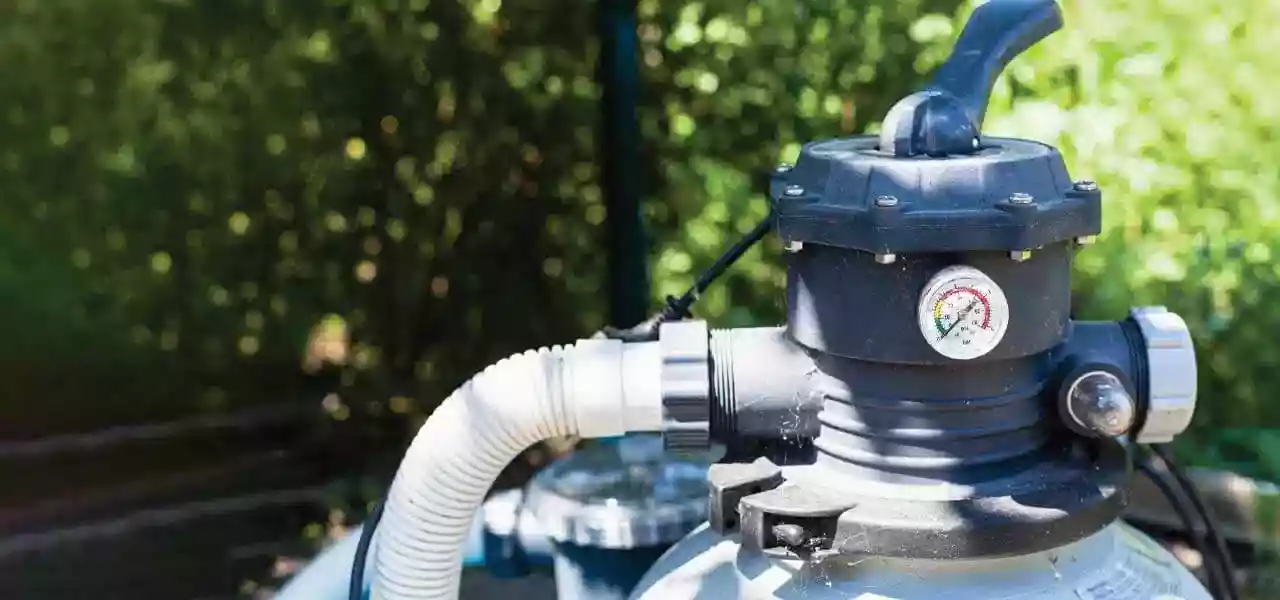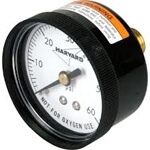FREE Standard Shipping On All Orders $100 or More!*

Pool Filter Pressure Problems
The pool filter pressure gauge is often a misunderstood and under-appreciated piece of pool equipment. Part of your pool's main filter tank, it serves a very important function — letting you know the pressure inside your filter tank. The pressure level inside your filter tank indicates how well the filter system is operating.
Many people don't know that every filter system operates at a different pressure. Your filter may be clean and normal at 9–10 psi, but your neighbor's filter gauge could run higher, and be clean at 15-16 psi. Some systems with low resistance can run very low pressures, while other filter systems can run quite high, pushing 30 psi when the filter becomes dirty.
Today's post discusses how to read your filter pressure gauge. Which will help diagnose circulation or filtration problems, and how to know if your pressure gauge is trustworthy. We'll also talk about the air bleeder assembly, which most filter pressure gauges are screwed into.
What Should the Filter Pressure Gauge Read?
Common question, but each pool filter system has its own "pressure personality," and there isn't a singular pressure range that's correct for all pool filters. If anything could be considered "normal," it would be about 10 psi. Most filter systems are designed to operate in the 5–15 or 10–20 psi range. The way to find out your filter's correct pressure range is to clean or backwash the filter thoroughly and empty the pump and skimmer baskets. Start the filter, and when it reaches its full head, note the pressure gauge reading. That is your clean, or starting, pressure. It should never drop lower than that, and if it increases 5–10 psi above that starting pressure, it's time to clean the filter again.
The pool filter pressure should be steady within this range. When it's outside this range, either very low or very high, then you'll know something's wrong. Some gauges allow you to set the clean and dirty range, or you can write it on the filter tank with a marker.
Types of Pool Filter Pressure Gauges

Pool filter pressure gauges are typically a 0–60 psi gauge, with a 1/4" NPT threaded attachment. The threads can be on the bottom of the gauge (used on top of DE, cartridge, and side mount sand filters), or on the back of the gauge (back mount) for sand filters with the valve on top. A 0–30 psi gauge can also be used for pool filters.
Digital pressure gauges are available, but they are more costly than traditional gauges. In fact, digital gauges can be 10x the cost of traditional analog pressure gauges. Oil-filled pressure gauges with a stainless steel body are more durable than regular gauges with plastic or powder coated steel cases, but they're not necessary.
Common Filter Pressure Problems
Your filter is one of the most important pieces of pool equipment and is crucial to keeping your pool clean and healthy. A malfunctioning or dirty filter will cause many other pool problems, like cloudy water, algae growth, etc. Below is a list of common pool filter issues and how to resolve them. Remember, always check your filter pressure gauge to determine the overall health and functionality of your pool filter.
Low Pool Filter Pressure
When the pressure is lower than normal, this usually indicates a flow problem before the pump. Something is blocking or restricting water flow into the pool pump. It's never a problem after the pool pump, because after the impeller, the pool water is under pressure, and obstructions result in higher than normal pressure. It bears repeating: when pool pressure gauge reading is low, look for the problem at the pump or before the pump. These are some common causes of low filter pressure:
- Clogged pump basket or skimmer baskets
- Clogged pump impeller
- Eyeball fittings not in place at pool returns
- Filter valve allowing water to bypass filter
- Air pulling into system at pump intake or pump lid, or valves
- Closed or partially closed skimmer or main drain valves
- Clogged skimmer pipes or main drain cover
- Cracked or collapsed skimmer pipes
High Pool Filter Pressure
When the filter pressure is higher than normal, this also indicates a flow problem. But in this instance, the problem is after the pump, not before. High pressure usually indicates a dirty pool filter, meaning it's time to backwash or clean the filter cartridge. Be careful with high filter pressure, as filter tanks can rupture with deadly force. Always keep your hand on the switch and your eye on the pressure gauge when starting a pool filter. If you see the pressure begin to rise, shut off the pump immediately, and look for one of these problems below:
- Dirty pool filter
- Closed or partially closed return side valves
- Plugs left in wall, or restrictive eyeball fittings
- Filter media (sand, grids, cartridge) problems
- Broken internal filter valve parts (multiport or push-pull)
- Broken internal filter or heater parts
- Lime deposits inside gas heater heat exchanger
Filter Pressure Gauge is Stuck
A pool pressure gauge that stays in one spot and never fluctuates is concerning. Is it working? Does it go back to zero when you shut off the pump? Is it properly sized? 0-60 psi is the standard pool filter pressure gauge. Some filter systems operate on clean pools with a very small range, and can run for months and only increase a couple psi on the pressure gauge. These filters are generally oversized with smaller pumps, which is a good way to go. If your pressure gauge doesn't move at all, it might be time to replace it with a new one.
Filter Pressure Gauge is Not Working
If the pressure gauge appears to be hibernating, gently — and we mean gently — tap it with your finger. Shut off the pump if this tried and true method doesn't work, and the gauge should go to zero. If the gauge stays at zero when you turn the pump on, the air bleeder assembly under the gauge is probably clogged. Remove the gauge and the assembly, and clean out the inner cavity.
If the pressure gauge needle stays in place when you shut off the pump, the dial is likely bent. Metal gauges can become faulty and rust where the pin holds the needle. Plastic gauges can warp in the sunlight, and the face/dial can bend. If your filter pressure gauge is broken, it's simple to replace. Be sure to use Teflon tape on the threads before screwing it into place.
What is the Filter Pressure Gauge Air Relief Valve?
The air relief valve, also known as the bleeder valve, bleeds trapped air from the pool filter. In practice, it's meant to be opened after you start the pool pump, to release air trapped at the top of the filter tank. Close the valve knob once the water starts to spray out of the valve.
Filter Pressure Gauge is Stripped
It's probably not the gauge that's stripped, but for sand filters with top mounted valves, the gauge screws into plastic threads in the multiport valve housing or body. If the pressure gauge is cross threaded, this can damage the threads. A 1/4" NPT tap can be used to gently re-cut the threads again, and extra Teflon tape around the pressure gauge threads. If that fails, you can tap it out larger, to 5/16", and then use a threaded brass insert of the right size. If that fails, you will need to replace the valve body (or the entire valve), if the leak is excessive.
Filter Pressure Gauge is Leaking Water
Rarely do pressure gauges leak water, but they can. Use a 1/4" pump plug in place of the gauge until you buy a new pressure gauge. Usually the leak of a pressure gauge is actually the air relief assembly leaking water, not the gauge. A leaking air relief valve can often be repaired with Teflon tape, or by replacing a small o-ring on the knob, or by installing a new air relief valve. The old Pac-Fab air bleeder fits many filters. For others, like Hayward filters, visit our parts department to order the correct air bleeder parts for your pool filter.
Taking care of your pool filter will keep your pool clean and healthy. Check the filter pressure gauge often to stay on top of your filter's cleanliness and efficiency.